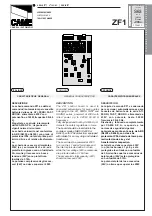
16
NOTE
: Waterflow zones always require single EOL
resistors regardless of any other programming. Refer
to the wiring diagram or Section 2.9 “Zone Wiring”
for zone configuration.
Fire Supervisory (11)
A Fire Supervisory zone monitors fire critical systems to
indicate when those systems are in a condition that could
prevent normal operation. This zone will indicate an
“Off-Normal Supervisory” condition when a short cir-
cuit is detected. When the zone is open, a zone trouble
will be indicated and the keypad will beep.
24 Hour Zones (Types 12-24)
These zones are always active. When violated, they will
create an alarm, whether the partition is armed or dis-
armed.
For Types 16-21
: When violated, the panel will immedi-
ately latch the bell outputs and will communicate to the
central station. Each zone has a different SIA identifier.
•
24 Hr Bell (12):
This zone, when violated, will activate
the burglary outputs.
•
24 Hr Bell/Buzzer (13):
This zone, when violated, will
create an alarm whether the partition is armed or dis-
armed. However, if the panel is armed, it will activate
the burglary outputs; if disarmed it will activate the
keypad buzzer.
•
24 Hr Buzzer (14):
This zone, when violated, will acti-
vate the keypad buzzer.
•
24 Hr Technical (15):
This zone is silent.
•
24 Hr Gas (16):
This zone is audible.
•
24 Hr Heat (17):
This zone is pulsed audible.
•
24 Hr Medical (18):
This zone is silent.
•
24 Hr Emergency (19):
This zone is audible.
•
24 Hr Water (20):
This zone is audible.
•
24 Hr Freeze (21):
This zone is audible.
•
24 Hr Holdup (22):
This zone is silent. It does not acti-
vate Burglary outputs or the Latched Strobe output.
•
24 Hr Panic (23):
This zone is silent. It does not activate
Burglary outputs or the Latched Strobe output.
Latching 24 Hr (24)
When violated, this zone will operate the same as the 24
hour bell zone (12) with one exception: the installer’s
mode ([*][8]) must be entered before the system can be
armed. The keypad display will read “Arming Inhibited
Call for Service.” This is to ensure that the problem will
be examined by the installer.
Momentary Arm (25)
A momentary closure of this zone will alternately arm
and disarm the partition. This zone can be used with a
keyswitch to arm and disarm the system.
NOTE
: This zone type must not be used as a global
zone. If a keyswitch zone has been tampered or
faulted, the zone must be restored before it can be
used to arm or disarm the system.
Maintained Arm (26)
When this zone is closed, the partition will disarm. When
this zone is violated, the partition will be armed. This
zone can be used with a keyswitch to arm and disarm the
system.
NOTE
: This zone type must not be used as a global
zone. If a keyswitch zone has been tampered or
faulted, the zone must be restored before it can be
used to arm or disarm the system.
Forced Answer (27)
When this zone is tripped, the panel will instantly pick
up the telephone lines to search for a downloading com-
puter. Do not use this zone type to monitor for alarms.
LINKS Sup (28)
The LINKS Supervisory zone is used with a LINKS mod-
ule to monitor for LINKS troubles. When the LINKS
PGM output activates, a LINKS trouble will be logged on
the event buffer and the zone trouble will be transmitted.
NOTE
: LINKS Supervisory zones always require single
EOL resistors regardless of any other programming.
Refer to the wiring diagram or Section 2.6 “Special-
ized Zone Wiring” for zone configuration.
LINKS Answer (29)
The panel can be uploaded/downloaded via the cellular
network. If the LINKS1000 detects an incoming call, it
will activate an output which can be used to violate this
zone type, forcing the panel to answer the cellular call
and begin communicating with the downloading com-
puter.
NOTE
: LINKS Answer zones always require single EOL
resistors regardless of any other programming. Refer
to the wiring diagram or Section 2.5 “Zone Wiring”
for zone configuration.
Zone Attributes
The following is a description of each zone option. Scroll
through each option and press [*] to toggle between on
and off. When all necessary changes are made, press [#]
to return to the previous menu.
Each zone type has different attributes enabled by
default. For a list of these default settings, see the PC4020
Programming Worksheets.
•
Bell Audible
– This will determine whether the zone
will activate bell outputs and PGM outputs pro-
grammed to sound fire/burglary alarms when an
alarm occurs. Select [Y] for audible, [N] for silent.
•
Bell Pulsed –
This will determine how the bell outputs
and PGM outputs programmed to sound fire/burglary
alarms will sound for an alarm. Select [Y] for pulsed,
[N] for steady.
•
Bypass Enable –
This will allow the zone to be manu-
ally bypassed. Select [Y] to allow bypassing by the
user, [N] to prevent it. This attribute should not be
enabled for Fire zones.
•
Chime Function –
If the door chime option is enabled,
keypad will chime both when the zone is violated and
restored. Select [Y] for chime, [N] for no chime. To acti-
vate/deactivate the Door Chime feature for a partition,
enter [*][4] at a keypad.
•
Force Arm –
When force arming is enabled, the parti-
tion(s) the zone is assigned to can be armed even if the
zone is not secure. The zone will be temporarily
bypassed and will be added back into the system if it is
later restored. Select [Y] to enable this feature. If [N] is
selected, the zone must be secured or manually
bypassed before arming will be allowed.
















































